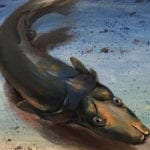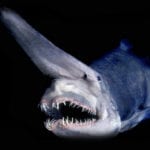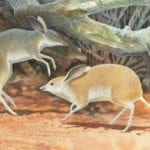 Miscellaneous
Miscellaneous  Miscellaneous
Miscellaneous  Our World
Our World 10 Green Practices That Actually Make a Difference
 Humans
Humans Ten Historic Men Who Deserve Way More Credit Than They Got
 Movies and TV
Movies and TV The 10 Most Heartwarming Moments in Pixar Films
 Travel
Travel Top 10 Religious Architectural Marvels
 Creepy
Creepy 10 Haunted Places in Alabama
 History
History Top 10 Tragic Facts about England’s 9 Days Queen
 Food
Food 10 Weird Foods Inspired by Your Favorite Movies
 Religion
Religion 10 Mind-Blowing Claims and Messages Hidden in the Bible Code
 Facts
Facts 10 Things You Never Knew about the History of Gambling
 Miscellaneous
Miscellaneous Ten Groundbreaking Tattoos with Fascinating Backstories
 Our World
Our World 10 Green Practices That Actually Make a Difference
 Humans
Humans Ten Historic Men Who Deserve Way More Credit Than They Got
Who's Behind Listverse?

Jamie Frater
Head Editor
Jamie founded Listverse due to an insatiable desire to share fascinating, obscure, and bizarre facts. He has been a guest speaker on numerous national radio and television stations and is a five time published author.
More About Us Movies and TV
Movies and TV The 10 Most Heartwarming Moments in Pixar Films
 Travel
Travel Top 10 Religious Architectural Marvels
 Creepy
Creepy 10 Haunted Places in Alabama
 History
History Top 10 Tragic Facts about England’s 9 Days Queen
 Food
Food 10 Weird Foods Inspired by Your Favorite Movies
 Religion
Religion 10 Mind-Blowing Claims and Messages Hidden in the Bible Code
 Facts
Facts 10 Things You Never Knew about the History of Gambling
10 Sensational Spider Species
Spiders are creatures that are both familiar and feared, frequently encountered, and yet sometimes capable of inducing serious injury or death through their venom. The spider is a form of creature that may induce instinctive anxiety in humans that may be regarded as a phobia. In certain species, this apprehension is justified. In other species, little danger to humans may exist, but eerie reproductive ways, predation habits, or bizarre physical attributes just might cause one to lose some sleep.
10 Plant-Eating Spider
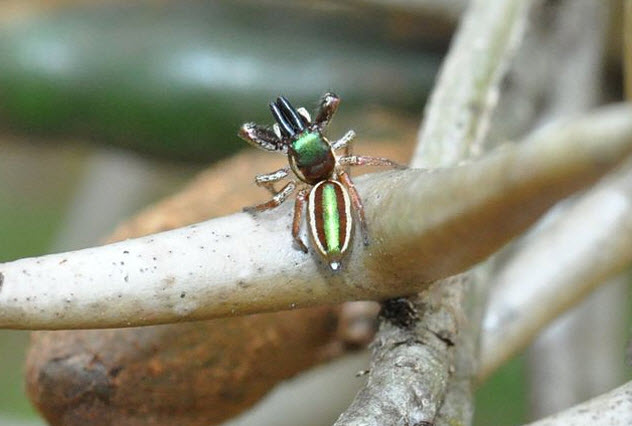
Spiders are renowned for their aggressive predatory habits, but we will start this list with an ironic discovery that might just seem anticlimactic were it not so remarkable. There is a plant-eating spider on this planet. Native to areas with acacia vegetation in southeastern Mexico and northwestern Costa Rica, Bagheera kiplingi feeds on protein and lipid-rich Beltian bodies, small extensions found on the tips of the acacias on which this species lives.
Forming the bulk of the spider’s diet, the extensions seem to substitute for a diet of animal prey, giving ample nourishment to this very unique animal. Originally discovered in the 1800s, the spider was named by naturalists after Rudyard Kipling due to the author’s references to leaping panthers in The Jungle Book, to which the agility of the spider was compared. In 2001, Eric Olson of Brandeis University discovered the herbivorous behavior in Costa Rica before it was discovered in the Mexican portion of its range by Christopher Meehan from Villanova University.
However, there is a complication to living on the acacia plants in the form of a mutual relationship between the plant and the ants residing in the hollow thorns of the acacia. The ants attack animals that try to eat the acacia. In return, the ants feed on the Beltian bodies and shelter in the thorns.
Yet, the spiders are able to compete with the ants for Beltian bodies by living on dead leaves where the ants will not go, making forays into the plant to grab Beltian bodies before deftly escaping the ants. In an interesting alternative use of an existing adaptation, these peculiar plant-eating spiders use their exceptional jumping abilities, which in other spider species would be used to secure prey to obtain a meal without being attacked themselves. Rarely, these spiders will feed on the larvae of the dangerous ants, but they are primarily herbivorous, leading an exceedingly unusual life.
9 Pelican Spider

The outlandish pelican spiders of Australia, Madagascar, and South Africa set a new standard of strange in the evolutionary advancement of arthropods. Looking uncannily like a tiny replica of its namesake bird, pelican spiders have dramatically extended jaw parts and necks.
An elongated neck extends from the animal’s small body, with a head on top of the neck that has the angular shape of a real pelican. Tiny eyes are located at the front of the birdlike head, where dramatically elongated chelicerae, jawlike structures with projecting fangs, extend downward in parallel with the neck and slightly beyond. And form paves the way for rather eerie and remarkable function of what some might at first glance imagine to be its quasi-cannibalistic nature.
Members of the family Mecysmaucheniidae feed on a variety of prey items, but the Archaeidae actually feed on, of all things, other spiders, achieving success through a startling and cunning use of their remarkable physiological adaptations. Creeping up to the web of a normal spider, the pelican spider taps the web to mimic the struggle movements of a captured insect.
The long neck and fangs assist the pelican spider in reaching into the web without itself being captured. Once the spider comes close, the pelicanesque “beak” stabs the prey in spear fashion and injects venom through the fangs borne by its tip. After a struggle, the prey is dragged out of the web and consumed.
8 Australian Jumping Spider
Oh, the trials and triumphs of spider courtship! Tales of woe on the fate of hapless male black widow spiders are all too familiar in the annals of natural history. However, another very different species of spider stands out though its rather peculiar take on courtship. The male Australian jumping spider spider (Jotus remus), discovered in 2014 by Australian photographer and Australian Department of Agriculture staff member Jurgen Otto is still wary of being attacked by the female.
Thus, the male plays hard to get in a slightly coy and even deceptive way to attract her attention. This diminutive spider has small paddles on two specially modified legs, which it waves as it plays hide-and-seek behind leaves to impress females. Somewhat heart shaped, these paddles are structures that stand out as unique assets among spiders known to science.
The “peekaboo” fashion of behavior continues until the female is likely to be in a receptive position and less prone to suddenly attack the male. At this point, the male abandons his display and mates with her, his colorful patterns still standing out in the animal’s vegetated habitat.
7 Six-Eyed Sand Spider
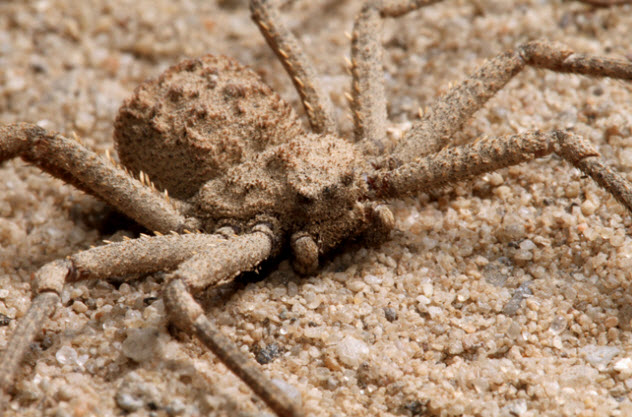
The six-eyed sand spider (Sicarius hahni) is a lesser-known and fearsome marvel of nature hailing from the sandy deserts of the southern regions of the African continent. Named after little-known German naturalist Carl Wilhelm Hahn, this species has a remarkable hunting strategy that adds to the mystery around this potentially dangerous species.
This sand-colored spider with the 14-centimeter (6 in) leg span swiftly buries itself in the sand in a manner that has to be seen to be believed. It frenetically digs sand to make room for its abdomen before placing the sand back over most of its body in a sweeping motion like a windshield wiper. With a life span of up to 15 years to perfect its hunting technique, the six-eyed sand spider lies buried in sand to conceal its predatory presence, stays motionless until prey comes within striking distance, and then lunges forward to capture its prey.
While the prey captured is small, this creepy-looking, prehistoric spider, known to be a living fossil that may recall some crabs in appearance, can survive up to a year on just one meal if it has eaten properly. The genus name Sicarius translates directly to “murderer,” and this is where the danger to humans comes in, along with a degree of mystery.
The six-eyed sand spider has necrotic venom, with effects on humans that are not yet fully known. The bite of this spider is fatal to rabbits within 5 to 12 hours according to tests. While no confirmed human deaths have taken place, a loss of a limb and a fatality are potentially linked to this species.
With its hemolytic and necrotic venom causing leaks in blood vessels while destroying flesh through direct cell death, this species may be the most dangerous spider in the world, capable of killing humans in the same manner as smaller mammals. No antivenom exists, either, in case any peace of mind remains.
6 Ogre-Faced Spider
Looking like a fusion of arachnid body parts and robot eyes while acting like the arthropod world’s answer to a human net fisherman, the tropical and subtropical spiders in genus Deinopis have eerie faces and exceptional hunting ability. While most spiders have eight eyes but poor vision, the ogre-faced spiders are named for their bizarre, elongated faces and enormous, “posterior median eyes.”
The enormous eyes resemble a huge pair of binoculars embedded in the spider’s face, dwarfing its six smaller eyes and lending extraordinary visual capabilities. These abilities include exceptional night vision and clarity of view, enabling prey to be precisely tracked and targeted.
If the bizarre, sticklike shape and night vision monster eyes are not enough, this animal is the answer to a human fisherman in the aerial environment. With special hairs on its legs and remarkable dexterity, ogre-faced spiders weave a unique, net-shaped structure in lieu of a typical web. This structure is held between the four front legs and hurled upon passing insects, either flying or walking.
Flying insects are captured in a backward flinging motion, while a walking insect is caught when the net is pushed down onto the unfortunate creature. Unlike the creations of more normal spiders, this web structure is not actually sticky. Instead, it functions in the same manner as a fisherman’s net.
5 Spitting Spider
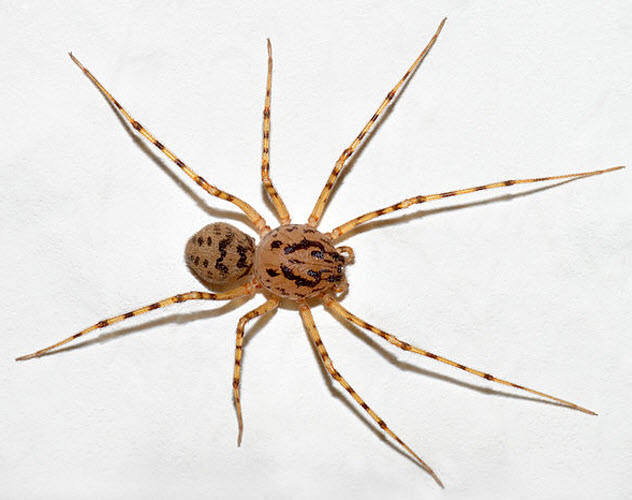
Forgoing a web for a more mobile mode of hunting, members of the family Scytodidae, the spitting spiders, constitute a particularly unique form of arachnid exceptionalism. Spitting spiders lack the silk-producing spinnerets common to more typical spiders.
Instead, these creatures live in forests and scamper around in pursuit of small prey items, which they capture by spitting a sticky, venom-infused mixture of fluids that immobilize the prey. The fluids are expelled from the poison glands and then fall upon the prey.
Next, the spider seizes the victim and injects a powerful venom that liquefies the insides of the prey before consumption. With a spindly appearance, the spiders have notably large venom glands to facilitate their copious spraying of venom and mucus.
The larger the prey, the greater the amount of mucus lobbed in its direction. The mucus is distributed through a head-shaking, spraying motion. Furthermore, these spiders have an interesting reproductive history to complement their remarkable hunting strategies. Females take two to three years to reach maturity and select males based on their pheromones. Mating takes place based on chance encounters, with care being taken by males to avoid being mistaken for prey.
4 Black And Yellow Garden Spider
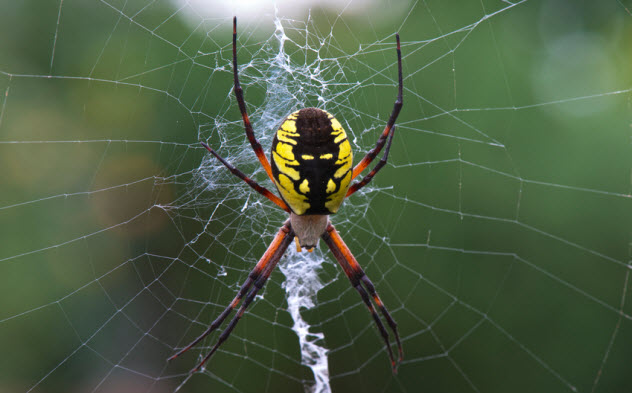
This list shows that not only are spiders original and remarkable but there seems to be a spider to fit nearly every possible animal form. You name it: pelicans, scorpions, and now if you have not seen it all, a spider the color of a stinging wasp or bee.
While spiders can inject venom, it is reasonable for the enterprising naturalist to conclude that they are not quite capable of deterring many dexterous predators by this attribute alone. Spiders are frequently plucked from their webs by foraging birds, but a black and yellow garden spider may discourage such a hunter through its beelike or wasplike appearance. The logically named black and yellow garden spider is a fairly normal spider of the orb weaver variety found throughout much of North America.
The yellow garden spider, like many arachnids, is a species where sexual dimorphism means that males get the short end of the stick—literally. A grown male black and yellow garden spider is around one-fourth of the size of an adult female. Amusingly, males are also less colorful than females when compared to many species such as the majority of birds. Ironically, black and yellow garden spiders may consume the very wasps and bees that their appearance mimics should one of these insects become stuck in its web.
3 Sowbug Killer Spider
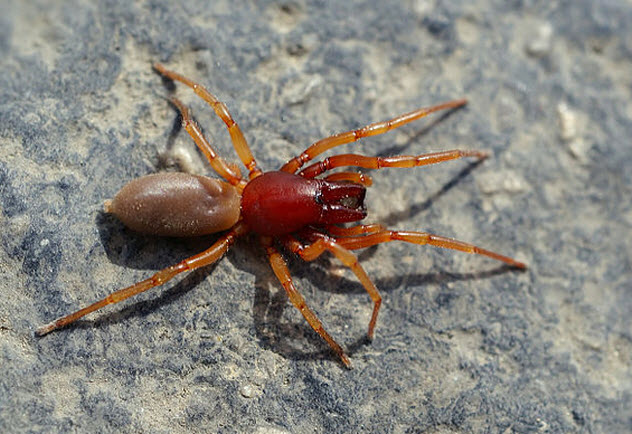
For various reasons, many people dislike sowbugs, more correctly known as woodbugs or woodlice, despite their actual classification as crustaceans. The name “sowbug killer spider” or “woodlouse hunter spider” will make this spider seem welcome to those experiencing a woodbug infestation.
Nonetheless, these spiders have a rather intimidating appearance and predatory capabilities, traits that equip them well for their more challenging lifestyle. With a reddish thorax, colorful legs, and beige abdomen, these spiders are unnervingly smooth and shiny in appearance with enormous fangs for their fairly respectable body size. Rather than spinning a web, the spider stalks and ambushes its land-dwelling crustacean prey before injecting venom.
There is a problem, however. Sowbugs have hard, chitinous shells that protect them from predators. With its disproportionately long, reinforced fangs, the spider pierces the target’s armor and injects a lethal venom, efficiently disabling the prey before preparing it for consumption.
The woodlouse hunter occurs in a broad range of woodlouse-supporting environments in North America, Europe, England, and Australia. Although this species has not been proven to be a seriously venomous spider to humans, there is cause for concern in handling this oversize, fang-bearing spider. According to the Penn State College of Agricultural Sciences, skin irritations known as erythema were attributed to the venom of this species.
2 Scorpion-Tailed Spider

The scorpion-tailed spider is one of those creatures that will make even the most seasoned naturalist pause for thought and say, “I thought I had seen it all.” Native to Australia and resembling a scorpion climbing in a spider’s web at first glance, the female of this remarkable species has a yellowish color and a body plan that presents a bit of a mystery of adaptation. Despite the animal’s outlandish appearance, scorpion-tailed spiders are very similar to regular web-making spiders, except for the female’s remarkable body appendage.
Extending from the abdomen is a giant formation that exceeds the length of the spider itself. The result of bearing the appendage is a rather leaflike appearance, but curiously, the appearance is also remarkably close to that of a genuine scorpion.
When disturbed, this species will curl up its tail in scorpion fashion, intimidating any predator that attempts to consume it. A pronged, clublike structure exists at the end of the appendage, perhaps resembling the clubs on some primitive species of dinosaur in miniature form. The spinnerets are not located at the end of the extension but right on the end of the main portion of the abdomen, the same as a “normal” spider.
1 Whip Spider
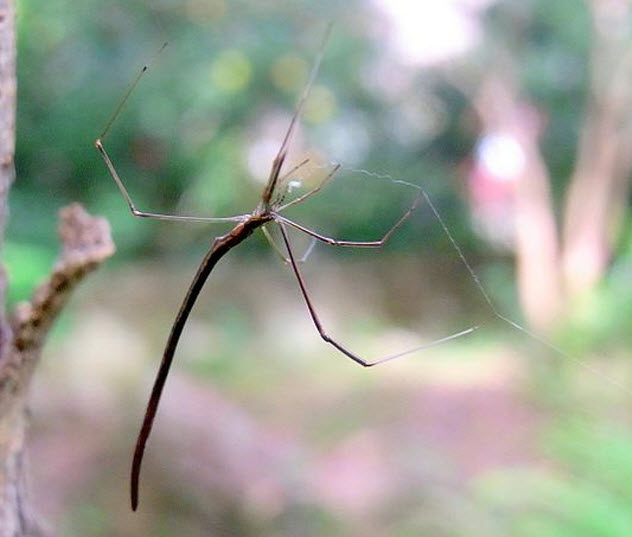
Stick insects are remarkable insects in their own right, and in keeping with our theme of mind-boggling spiders that look like anything but themselves, we now reveal a spider that looks for all the world like a genuine stick insect. The whip spider (Argyrodes colubrinus) of Australia has eight legs like all spiders, but the rounded abdomen typical of the spider form is replaced by a sticklike form with a remarkable length-to-width ratio.
Being remarkably slim, the abdomen is only 1 millimeter (0.04 in) wide. Yet females grow up to 22 millimeters (0.90 in) in length while males only reach 13 millimeters (0.50 in). It is from this body shape that the spider derives its name.
Suspended from a simple, minimalist web consisting of a few strands of silk, the spider drops down to capture its prey. This consists of wandering spiders, which are captured when the spider senses the movement of prey in the web and drops down for the kill.
It is believed that the spiders frequently prey on the smaller males of other species rather than focusing their hunting effort on females. The spiders retreat to hang off plants at night, but during the day, they camouflage themselves as broken sticks, just as a stick insect would.
Christopher M. Stephens, Msc., is an ecologist, conservation planning consultant from British Columbia, Canada, with a passion for discovering the most startling secrets of our natural world. He is the birding tour leader for Pacific Rainforest Adventure Tours, offering international visitors the opportunity to see remarkable Canadian birds up close and accepts custom bookings throughout the year.

